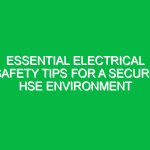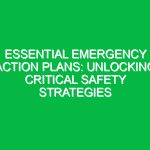Good morning, team! Today, we’re gathered for our Toolbox Talk to focus on an essential Safety topic that affects all of us in our daily operations: preventing slips. Slips may seem minor, but they can lead to serious accidents, injuries, and workplace disruptions. Our goal is to understand how we can minimize these incidents and maintain a safe working Environment. Let’s dive into the details!
Understanding Slips in the Workplace
Slips occur when there is a loss of traction between your footwear and the walking surface. This can happen due to various reasons such as wet floors, uneven surfaces, or inappropriate footwear. In the Health, Safety, and Environment (HSE) context, slips are not just an inconvenience; they represent a significant hazard that can lead to injuries ranging from minor bruises to severe fractures.
The Importance of Preventing Slips
Why is preventing slips so important? Here are a few key points to consider:
- Injury Prevention: Preventing slips protects you and your colleagues from potential injuries, which can lead to time off work and even long-term health issues.
- Increased Productivity: A safe work environment fosters productivity. When employees feel safe, they can focus on their tasks instead of worrying about potential Hazards.
- Cost Reduction: Reducing slip incidents can lower costs related to workers’ compensation claims, training of replacement staff, and potential damage to company property.
- Regulatory Compliance: Following Safety protocols helps ensure compliance with Workplace Safety regulations, reducing legal liabilities for our organization.
Common Causes of Slips
Understanding the common causes of slips is crucial in preventing them. Here are some prevalent factors:
- Wet Surfaces: Spills, rainwater, or cleaning processes can create slippery conditions.
- Uneven Surfaces: Cracks, holes, or debris on walking paths may lead to tripping and slipping.
- Inappropriate Footwear: Wearing shoes that lack proper grip can increase the risk of slipping.
- Poor Lighting: Insufficient lighting can make it difficult to see Hazards, increasing the likelihood of slips.
- Weather Conditions: Ice and snow accumulation can create hazardous walking conditions outdoors.
Identifying Slip Hazards
As we move through our daily tasks, it’s essential to remain vigilant and identify potential slip hazards. Here are some practical tips for recognizing these hazards:
- Regular Inspections: Conduct routine inspections of work areas to identify wet surfaces, debris, or uneven flooring.
- Pay Attention to Weather: Be mindful of weather conditions and how they may affect outdoor surfaces.
- Trust Your Instincts: If something looks unsafe, it probably is. Always report potential hazards to your supervisor.
Best Practices to Prevent Slips
Now that we know what causes slips and how to identify hazards, let’s discuss some Best Practices to help prevent slips in our work environment:
1. Maintain Clean Work Areas
Keeping work areas clean and free of obstacles is critical. Ensure that spills are cleaned immediately, and tools or materials are stored properly to avoid clutter.
2. Use Proper Footwear
Wear shoes that provide good traction and support. Shoes with non-slip soles can significantly reduce the risk of slips, especially in areas prone to wetness.
3. Install Anti-Slip Mats
Where possible, use anti-slip mats in areas that frequently get wet, such as kitchens or bathrooms. These mats can provide extra grip and reduce slipping hazards.
4. Improve Lighting
Ensure that all areas are well lit. If you notice dark areas, talk to your supervisor about installing additional lighting.
5. Communicate Hazards
If you spot a potential slip hazard, communicate it to your team and supervisors immediately. Using caution signs can alert others to temporary hazards.
Real-Life Examples of Slip Incidents
To illustrate the importance of slip prevention, let’s look at some real-life scenarios:
Scenario 1: The Wet Floor
Imagine a scenario where a co-worker spills water in the break room. If the spill isn’t cleaned up promptly, someone could easily slip and fall, resulting in an injury. By immediately cleaning up spills and placing a caution sign, we can prevent accidents.
Scenario 2: The Uneven Surface
Consider a situation where there is a cracked tile in a hallway that is often overlooked. An employee rushing to meet a deadline trips and injures themselves. Regular inspections and Maintenance can help identify such hazards before accidents occur.
Regulations and Standards
It’s essential to be aware of relevant Regulations and standards concerning slips in the workplace. The Occupational Safety and Health Administration (OSHA) provides guidelines that outline safety requirements to prevent slips, trips, and falls. Compliance with these regulations not only ensures safety but also protects the organization from legal liabilities.
Moreover, our company has specific policies in place regarding Workplace Safety that align with these regulations. Familiarizing yourself with these policies can reinforce our collective commitment to maintaining a safe work environment.
Engaging with the Team
As we wrap up today’s Toolbox Talk, I’d like to open the floor for discussion. Here are a few questions to consider:
- Have any of you experienced or witnessed a slip incident? What could have been done to prevent it?
- Are there any additional slip hazards you think we should be aware of?
- What personal strategies do you use to stay safe and prevent slips in your daily tasks?
By sharing our experiences and insights, we can learn from each other and enhance our safety practices. Remember, we all play a role in maintaining a safe workplace.
Conclusion
In conclusion, today’s Toolbox Talk has highlighted the importance of preventing slips within our work environment. By understanding the causes of slips, identifying hazards, and adopting Best Practices, we can significantly reduce the risk of accidents.
Thank you for your attention and your commitment to safety. Let’s continue to prioritize our well-being and the well-being of our colleagues. Remember, safety isn’t just a policy; it’s a culture we create together.


